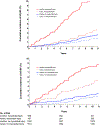Physical Activity, Subclinical Myocardial Injury, and Risk of Heart Failure Subtypes in Black Adults
- PMID: 34119468
- PMCID: PMC10563362
- DOI: 10.1016/j.jchf.2021.04.003
Physical Activity, Subclinical Myocardial Injury, and Risk of Heart Failure Subtypes in Black Adults
Abstract
Objectives: This study sought to evaluate the independent associations and interactions between high-sensitivity cardiac troponin I (hs-cTnI) and physical activity (PA) with risk of heart failure (HF) subtypes, HF with preserved ejection fraction (HFpEF) and HF with reduced ejection fraction (HFrEF).
Background: Black adults are at high risk for developing HF. Physical inactivity and subclinical myocardial injury, as assessed by hs-cTnI concentration, are independent risk factors for HF.
Methods: Black adults from the Jackson Heart Study without prevalent HF who had hs-cTnI concentration and self-reported PA assessed at baseline were included. Adjusted Cox models were used to evaluate the independent and joint associations and interaction between hs-cTnI concentrations and PA with risk of HFpEF and HFrEF.
Results: Among 3,959 participants, 25.1% had subclinical myocardial injury (hs-cTnI ≥4 and ≥6 ng/l in women and men, respectively), and 48.2% were inactive (moderate-to-vigorous PA = 0 min/week). Over 12.0 years of follow-up, 163 and 150 participants had an incident HFpEF and HFrEF event, respectively. In adjusted analysis, higher hs-cTnI concentration (per 1-U log increase) was associated with higher risk of HFpEF (hazard ratio [HR]: 1.47; 95% confidence interval [CI]: 1.25 to 1.72]) and HFrEF (HR: 1.57; 95% CI: 1.35 to 1.83]). In contrast, higher PA (per 1-U log increase) was associated with a lower risk of HFpEF (HR: 0.93; 95% CI: 0.88 to 0.99]) but not HFrEF. There was a significant interaction between hs-cTnI and PA for risk of HFpEF (p interaction = 0.04) such that inactive participants with subclinical myocardial injury were at higher risk of HFpEF but active participants were not.
Conclusions: Among Black adults with subclinical myocardial injury, higher levels of PA were associated with attenuated risk of HFpEF.
Keywords: Black adults; heart failure; physical activity; subclinical myocardial injury.
Copyright © 2021 American College of Cardiology Foundation. Published by Elsevier Inc. All rights reserved.
Conflict of interest statement
Funding Support and Author Disclosures Supported by a Strategically Focused Research Network Grant for Prevention from the American Heart Association to University of Texas Southwestern Medical Center, Dallas, and Northwestern University School of Medicine, Chicago. Dr. Neeland is a consultant for Boehringer Ingelheim/Lilly Alliance and Merck. Dr. deFilippi has received grant support from Roche Diagnostics, Ortho Diagnostics, and Siemens Healthineers; is a consultant for Roche Diagnostics, Abbott Diagnostics, Ortho Clinical Diagnostics, Quidel, FujiRebio, and Siemen’s Health Care Diagnostics; has received royalty payments from UpToDate; co-owns a patent awarded to the University of Maryland (U.S. Patent Application: 15/309,754; Methods for Assessing Differential Risk for Developing Heart Failure); and has received an award, UL1TR003015, from the U.S. National Institutes of Health/Center for Advancing Translational Science. Dr. Seliger has received funding from Roche Diagnostics. Dr. Rodriguez has received research support from Amgen, the American Heart Association, and the National Health Lung and Blood Institute (2R01HL104199). Dr. de Lemos has received grant support from Roche Diagnostics and Abbott Diagnostics; is a consultant for Roche Diagnostics, Abbott Diagnostics, Ortho Clinical Diagnostics, Quidel Cardiovascular, and Siemen’s Health Care Diagnostics; and is a co-owner of a patent awarded to the University of Maryland (U.S. Patent Application: 15/309,754; Methods for Assessing Differential Risk for Developing Heart Failure). Dr. Mentz has received research support and honoraria from Abbott, American Regent, Amgen, AstraZeneca, Bayer, Boehringer Ingelheim/Eli Lilly, Boston Scientific, Cytokinetics, Fast BioMedical, Gilead, Innolife, Medtronic, Merck, Novartis, Relypsa, Respicardia, Roche, Sanofi, Vifor, and Windtree Therapeutics. Dr. Berry has received a grant, 14SFRN20740000, from the American Heart Association prevention network and salary support from Abbott Diagnostics. Dr. Pandey has served on the advisory board of Roche Diagnostics; has received nonfinancial support from Pfizer and Merck; and has received research support from Texas Health Resources Clinical Scholarship, the Gilead Sciences Research Scholar Program, and the National Institute of Aging GEMSSTAR grant (1R03AG067960-01) and Applied Therapeutics.
Figures


Comment in
-
Physical Activity to Reduce Subclinical Myocardial Injury Associated Heart Failure in Blacks.JACC Heart Fail. 2021 Jul;9(7):494-496. doi: 10.1016/j.jchf.2021.05.004. Epub 2021 Jun 9. JACC Heart Fail. 2021. PMID: 34119467 No abstract available.
References
-
- Brown DW, Haldeman GA, Croft JB, Giles WH, Mensah GA. Racial or ethnic differences in hospitalization for heart failure among elderly adults: Medicare, 1990 to 2000. Am Heart J 2005;150:448–54. - PubMed
-
- Pandey A, Patel KV, Vaduganathan M et al. Physical Activity, Fitness, and Obesity in Heart Failure With Preserved Ejection Fraction. JACC Heart Fail 2018;6:975–982. - PubMed
Publication types
MeSH terms
Substances
Grants and funding
LinkOut - more resources
Full Text Sources
Medical
Research Materials
Miscellaneous

